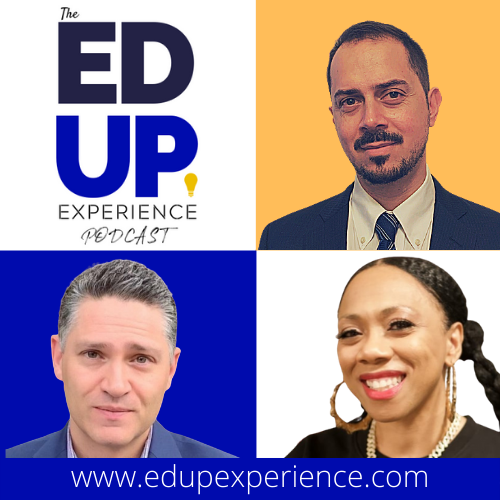Published on
A Purpose to Serve Students

The demands of today’s learners are changing rapidly, and higher ed has an opportunity to adapt and innovate to meet them. Students are the center of the institution, and the right services and programming must be in place for them—and the institution—to thrive. In this interview, Dr. Joe Sallustio and Liz Leiba talk to Wade Dyke about the philosophy behind the American Public University System, the importance of stackable credentials and how to meet new learner demands.
EdUp Experience: Can you talk about how you got your handled all the operations, everything that was happening at American Public?
Wade Dyke (WD): It’s a lot of up and down. One of the true strengths of organizations like ours and others that have walked into this space over the past few decades is that our background in remote learning, remote management has really served us well. A lot of these institutions pioneered remote work because we were very used to our faculty working remotely. We had a head start because of this history of remote work, and now it’s spread through the entire organization.
It can also be difficult to make a transition in this time because you’re trying to learn an organization and embrace its and change strategy as a new president. That’s a big learning curve, probably made more difficult by the current situation. But overall, I’d have to say that I’ve been very lucky to have the team I have.
EdUp Experience: What goes into your mind frame and philosophy, as you determine which types of courses to bring on?
WD: When American Military University was started almost 30 years ago, it was purpose-built for students. By building it according to student needs, the university was unique. All the processes, systems and programs were built with their needs in mind. Our faculty are terrific—they’re very active and creative. They created programs in cyber security, technology, supply chain, healthcare, environmental science and space studies—all of which are areas of high innovation. To really serve our students, we have to innovate to make sure they have access to programs that help them either improve their career or transition to something new.
We’ve tried to be very open as a resource for other institutions with an interest in this space. As we think about what’s coming ahead, it’s critical to keep in mind your purpose. You know what you’re trying to do. You’re not trying to build programs for everybody—you’re trying to build programs for the students you serve. That’s really been our MO: focusing on the needs of our student community—what helps them advance their education in the most affordable, effective way possible.
EdUp Experience: Can you talk a little bit about your system’s philosophy on textbooks and how we can be more responsive to students when it comes learning resources?
WD: Books became very expensive, not unlike the rest of higher ed. Costs went up across the board. We’ve always been mindful of what the active-duty military student can afford. With all that’s going on in publications, all that’s available on the internet, what institutions like Google have done to make open education resources available is truly remarkable.
The improvement in access to information from when we all started is just extraordinary. This is faculty-driven, but if a faculty member here sees good open resources that are available and satisfactory for the course, then we’re going to use the open resources. Obviously, if they’re not adequate, then there’s a cost, but we don’t pass that cost along. We eat that cost, in almost all cases. Because of the advance in open resources, we’ve found it a great way to both serve our students’ needs while staying affordable.
EdUp Experience: How is your team thinking about the trend of stackable credentials as a function of technology enablement and how you’re anticipating handling that going forward?
WD: It’s a cutting-edge topic in higher education. Being career-focused is going to be very important to one’s higher education career and the higher education ecosystem at large. We need to design programs to be stackable, to provide certificate opportunities along the way. But we also see a lot of other innovators out there doing the same, so there’s an opportunity to partner.
EdUp Experience: How do you prepare yourself for the changing education ecosystem? How is the military understanding the value of a degree?
WD: The degree is still highly valued in the military. In fact, the Navy is creating its own community college, at least on a pilot basis. There have always been service academies, but the military still highly values education as an important step in a military career—high school degree and beyond. They’ve, if anything, really increased their emphasis on education. Training was always a big part of what they do. We’ll see as the credentialing system grows the demand is for it grow as well. You’re just truly reaching more people with these different kinds of offerings.
The value of a college degree is still there. It’s still a very important part of someone’s career, but there are going to be more ways to achieve it, and there’ll be more people who want to get higher ed credentials than ever before.
EdUp Experience: How are you seeing the evolution of higher ed and traditional providers getting into more of the online learning space and adult learner spaces?
WD: I applaud them for seeing this as an important way to serve students. In 2009, when I got into online higher education, we were criticized, as though this was not an appropriate way to provide education. And I roll it back a little bit to the history of traditional institutions around business schools. It used to be the business college movement that was frowned upon in traditional education. Business studies were not considered appropriate in terms of traditional studies, then traditional institutions realized the for legitimate areas of academic inquiry. They then gradually migrated into that space and really crowded out a lot of the independent business colleges.
You see the same thing going on with online. You see traditional institutions embracing the platforms, which is a wise thing to do. There are a lot of adults, in particular, who need and use this service, but it goes back to making it affordable and setting people up to get a good return on their investment. That’s one of the things we’re most proud of. We’re among the top 100 institutions for ROI, in the top two percent of institutions.
EdUp Experience: Can you talk a bit about partnerships and share some advice on creating an environment focused on student support?
WD: There’s really an extraordinary opportunity here with the technology that has been and continues to be developed. It’s about looking at the end-to-end student experience to see how could we make it as painless as we can for the student. Technology tools today are getting better and better—this should be more possible.
We need partnerships around technology, folks who have really built interesting applications that can enhance the student’s journey. Our whole portal interface environment continues to expand, from places like the military into corporations and the like. There’s a technology enablement enhancing the student journey from beginning to end.
EdUp Experience: Have partnerships to build bridges between higher ed providers and employers been triggered by the pandemic?
WD: One of great strengths of the community and the technical colleges has been that local relationship with the employer community. They knew that the things they were providing to students through their education had an outcome at the end.
Going to university is not all about the job. As universities have become more expensive, and more people have access the system, more needs need to be fulfilled. They need successful employment outcomes, and besides, they have always expected that higher education to provide that.
We have to be very conscious of this. That’s why we invest in career services. It’s why we want people to be connected. There’s a lot more that can be done for universities to connect with the employment community.
EdUp Experience: Are there different demands on curriculum now than there were two years ago?
WD: There’s a demand for innovation—just keeping up with what’s going on with technology, with professions and the like. There’s a demand around inclusiveness. As we think about teaching new faculty members, what preparation do they need? We’re blessed by a very diverse community. In many ways, the U.S. military has been an innovator around diversity and inclusiveness for decades. We’re a beneficiary of that as an institution because it’s been very much on their minds, so it makes it very much on our minds. We have a very diverse student body and faculty. Those are areas that certainly touch us like they touch other institutions.
Edup Experience: Is there anything you’d like to add, and what do you see as the future for higher education?
WD: We take sustainability as an important part of higher ed’s future. It’s clearly top of mind for presidents everywhere. We signed onto the second nature climate neutrality commitment, and as we think about returning to work, we’re thinking hard about how we can do it in as carbon-neutrally way as possible. Obviously, that’s important to everybody.
In terms of the future of higher ed, people believe in it and want to achieve it. It’s hard to do sometimes. There’s a great future for higher ed, and people believe in the college degree. They want to be able to afford it and successfully navigate all the demands that it puts on them. Learning is a beautiful, wonderful thing for each of us, and when it can occur through a successful college degree, it’s such a joy. We see that every time our graduates post online or come to graduation. There’s a great future ahead for higher ed—there’s just a lot to figure out.
Listen to the full interview here.
This interview was edited for length and clarity.

Disclaimer: Embedded links in articles don’t represent author endorsement, but aim to provide readers with additional context and service.



